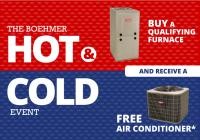One of the least understood aspects of your home’s comfort system is the indoor air quality. Most people assume that once they have a good furnace and air conditioner installed, there’s nothing left to worry about. However, with the push in the last 20 years to reduce energy loss through poor insulation, most homes are sealed up tighter than ever before. This doesn’t just cause stuffy indoor air – it can actually lead to illness.
How Bad Can Indoor Air Quality Get?
Homes built in the 1980s were recommended to have one third of the ventilation of those built before. Today, the standards have returned to their original levels, but for many years, homes were built with poor ventilation and excessive insulation. The result is a space that holds the air in too well. Everyday contaminants and allergens like dust, pollen, pet dander, mold, or smoke cannot get out of your home and as a result, you can get sick.
In fact, some people even suffer from Sick Building Syndrome (SBS). This is when they feel ill constantly, with respiratory symptoms that have no root cause and are hard to diagnose. Often, it is because they simply breathe too many contaminants and too much stale air.
Fixing Air Quality Is Simple
The first thing needed to fix air quality is a good filtration system. Despite what many people think, simple filtration is not that expensive. There are big, powerful purification systems with advanced ionization units and UV lighting to kill bacteria and viruses, but most families are served well with a simple HEPA filter to remove things like dust, pollen and dander.
It’s a good idea to have your indoor air quality tested, however, just to make sure other contaminants are not present. High humidity can lead to mold growth, and poor ventilation can lead to exhaust or gas fumes in your home. A good carbon monoxide detector is recommended for the latter, but testing should be done to make sure nothing else is floating around.
Finally, make sure your home is properly ventilated. Standard ventilation tends to leak heated or cooled air outside, so many homeowners now opt for energy recovery ventilators. These systems have heat exchangers that transfer warm air between indoor and outdoor air.
However you want to fix your indoor air quality issues, know that there are plenty of things you can do with the help of a good filtration device and regular cleanings of your ductwork and vents.


